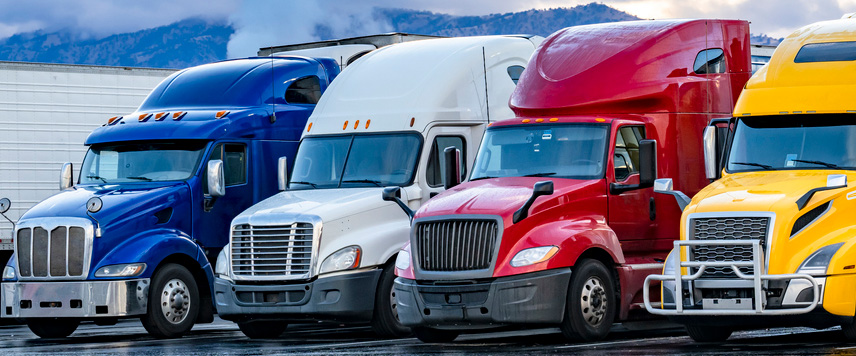AI, or Artificial Intelligence, has been a growing part of how people drive for several years now. Putting commercial trucking aside for just a moment, think about how AI affects the way people drive their passenger cars these days? If you’re not sure, that’s okay! Artificial intelligence has been slowly creeping into vehicles with small tools that almost everyone is used to using by now. Lane assist? It’s an AI-powered technology. The GPS that comes standard in most cars now? It uses AI to help predict alternative routes. (And thank goodness! Some of us are abnormally bad navigators.)
Taking these tools and applying them to the trucking industry has been seen as revolutionizing the way trucking is done. There are many applications for AI in the transportation field, and drivers, carriers, and retailers are all waiting to see how these changes affect their businesses. Today, the LZBlog is uncovering the ways trucks are already being outfitted with and using artificial intelligence and how those tiny pieces of technology will become more widely used in the future.
“…Ready for It?” And by “It”, I mean AI.
Everyone knows that AI is making its way into both cars and trucks, and researchers from places all over the world wide web are now scrambling to determine how this will affect the trucking industry. Ones like the trucking website RoadLegends.com, are going as far as saying “AI is revolutionizing the trucking industry by enhancing operational efficiency.” While levels of excitement varies from expert to expert, everyone seems to agree that AI is here to stay in the transportation field. So, what are supporters of artificial intelligence hoping to achieve in the trucking industry?
The first foray of AI into trucking, and the one with the most obvious benefits, involves route planning. For decades, drivers depended on dispatchers, paper maps, and their own memories to get from place to place. Millennials will be the first to gripe about having to “print out MapQuest directions,” but their experiences paled in comparison to the drivers who were up and down the roads every single day. These days, the GPS in a car seems easy enough to manage, but truck drivers can also access more help than just an easier way to get around town. Everyone is learning that there is so much more that this technology can do for truckers and their day-to-day lives. One of the great advantages of AI, according to the many technological experts, is the ability to tell the AI to process large amounts of data in very short order. By taking a driver’s route and analyzing the traffic, construction, and weather information along that road, the GPS can optimize the directions to allow drivers to reach their destination as quickly as possible and, more importantly, as safely as possible. A brokerage company called Sunset Transportation has even taken the tool a step further. When their “technology projects what weather systems might disrupt a shipment… based on information such as the driver’s destination and remaining hours of service,” Sunset’s AI tool will proactively inform the client waiting on the shipment that there could be a delay, making it an ideal tool for customer service as well. Alongside the optimization of directions, these types of AI systems fueling smarter routes can add to a driver’s fuel efficiency in their truck, leading to a cost reduction in gasoline.
Another form of AI in trucks are the tools that allow for predictive maintenance. “AI-driven predictive maintenance is transforming fleet management by optimizing vehicle maintenance schedules.” Maintenance has always been a problem for truck owners; knowing when to bring a vehicle in for work has been akin to a guessing game for ages. Now, with luck, predictive maintenance will replace preventative maintenance in the coming years. What does that mean exactly, though? Put simply, the dozens of brand new sensors and gauges being placed in today’s semi-trucks mean that there are loads of data coming from all parts of the vehicle. With AI being able to immediately comb through all of the newly available data, truck manufacturers are using this tool to let truck owners know what is going on with the vehicle at all times. Having all of this information allows for carriers and drivers to make plans in advance to bring a truck in for maintenance. “Given that equipment repairs and maintenance are some of the costliest expenses for owner-operators, this not only leads to safer vehicles, but also saves money.” Predictive maintenance allows drivers, as well as larger carriers, to better utilize the truck’s time and also prolongs the life of the vehicle itself.
Truck drivers, themselves, may not love the next use of AI, but carriers and dispatchers are finding that they can now schedule and plan loads easier with the new technology. For decades, truckers have been logging their hours and routes with pen and paper. While many older drivers still find this method the most accurate and easy to use, others are finding that AI is changing these old ways. As stated above, the AI system can pull tons of data and process it quickly. Now, supply chain and logistics can be streamlined, providing drivers with electronic routes that are faster and finding loads in different locations to minimize empty miles being driven. While individual owner-operators might struggle with these new tools, companies with hundreds or thousands of trucks and drivers can make significant forward strides by being able to optimize routes and loads with the help of AI. “With improved supply chain visibility and efficiency, trucking companies can enhance customer service, reduce costs, and maintain a competitive edge in the market.”
One of the best features of AI in trucking is improving the safety of trucking for drivers and the cars around them. Driver monitoring systems and Automated Driver Assistance Systems (ADAS) are becoming increasingly standard issue for semi-trucks, and their inclusion is creating better environments for drivers. These systems rely on the sensors sending information to the AI-driven data processing algorithms, and they are constantly monitoring the data being streamed into them. What do these products do, though? According to one researcher, “Driver monitoring systems (DMS) are specifically designed to detect distracted or tired drivers before an accident happens.” These days, truck drivers are in high demand, and their hours keep getting longer without relief. In this kind of situation, semi-truck drivers can become hazards on the road. Distracted or exhausted driving is a leading cause of accidents in the U.S., requiring special attention to help drivers stay safe and unharmed. DMS sensors can be placed in truck or as wearable devices on the drivers, and they are there to do things like track eye movements or “other human cognitive states,” such as yawning. From there, the system can recommend that the driver stop in the next available safe area, such as a rest area or hotel, for a break.
Conclusion
Artificial intelligence is already a part of the trucking industry, and as “technologies continue advancing, AI capabilities will become even more powerful.” While some drivers have had difficulties learning and operating new systems, they understand that the new tech is here to stay. From the cabs of their trucks to their wrists and everywhere in between, AI is changing the way the transportation industry functions. The uses above are only a few of the ways that AI is already making waves. However, there are so many more ways that AI is being tested in trucking. Some companies are integrating AI and virtual reality to create better training facilities and truck driving schools. Others are touting the fraud prevention possibilities that can come along with a fast data-processing program that checks up on the viability of companies without being asked. This blog hasn’t even touched on automated trucks that will be using AI technology. (For more information on Automated Trucks, see my blog from January 10, 2024!)
AI is daunting on the surface. As this blogger has learned from this research, there are so many uses and reasons to invest in AI, and not all of them can be covered in a short blog. While time marches on, the technology we use continues to grow with us. While AI is seen by some drivers as an extra way to “keep tabs” on them, it is important to understand that AI is more about keeping driver safety paramount. Justin King, chief product officer at technology vendor Transflo says “I think the most important thing to do is begin to embrace it… Just getting started is the most important part.”
__________________________________________________________________________
Meaghan Goldberg covers recruitment and digital marketing for Lionzone. A Patterson, GA native, after graduating from both Valdosta State University and Middle Tennessee State University, Meaghan joined Lionzone in 2018 as a digital recruitment strategist before becoming the social media manager.
Resources:
https://roadlegends.com/blog/post/artificial-intelligence-in-trucking
https://www.ttnews.com/articles/new-wave-ai-coming-trucking
https://altline.sobanco.com/how-will-ai-impact-the-trucking-industry/




